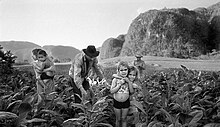Viñalesdalen
| UNESCO Verdensarvsområde Viñales Valley | |
|---|---|
 Viñalesdalen | |
| Land | Cuba |
| Type | Kultur |
| Kriterium | iv |
| Reference | 840 |
| Indskrevet | 1999 |
| Oversigtskort | |
Viñalesdalen (spansk: Valle de Viñales) er et er et karst-landskab, der er udnævnt til UNESCO Verdensarvsområde. Dalen er på 132 km2 og placeret i Sierra de los Organos, lige nord for Viñales i Pinar Del Rio provinsen på Cuba. Området er kendt for sine limstensklipper.
Tobak og andre afgrøder dyrkes på den meget frugtbare jord i bunden af dalen. I området findes der ligeledes mange huler (Cueva del Indio, Cueva de José Miguel).
Dalen er på grund af sin naturlige skønhed og relative nærhed til Havana (3 1/4 time i bus[1]), et meget besøgt turistområde på Cuba.
Referencer
- ^ "Viazul". Arkiveret fra originalen 24. juni 2010. Hentet 22. juli 2010.
Eksterne henvisninger
- Viñalesdalen på Radio Guama (Webside ikke længere tilgængelig)
|
Medier brugt på denne side
Forfatter/Opretter: Severin.stalder, Licens: CC BY-SA 3.0
Valle de Viñales, Pinar del Río, Cuba.
Valle de Viñales, Pinar del Río, Cuba.
Forfatter/Opretter: Manuel Rivera-Ortiz, Licens: CC BY-SA 3.0
Tobacco Harvesting, Valle de Viñales, Cuba, 2002. (Photo by Manuel Rivera-Ortiz; used with permission of author). Description by Rivera-Ortiz (used with permission of author): "A family of six grows tobacco in their farm which ends up in government warehouses to be shipped as cigars around the world. The family receives very little for their backbreaking work, with the rest of the profits from the sales of cigars going to government coffers for island-wide social programs. About 50,000 hectares (123,550 acres, or, 2.471 acres per hactare) are reserved for growing tobacco in Cuba. Tobacco is predominantly grown in the 90-mile-long (10-mile-wide) valley Vuelta Abajo, Pinar del Rio, where this photo was taken, at the foot of these limestone hills fraught with natural caves and tunnels which were once inhabited by Pre-Columbian Indians and later, by runaway slaves. In 1999, Altadis, a Franco-Spanish tobacco giant, is said to have signed a $500 million USD deal to take over a 50% stake in Cuba’s state owned firm Habanos S.A."






